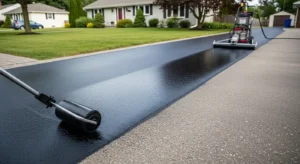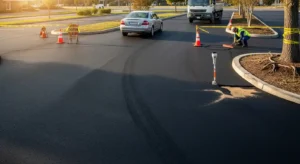
Choosing the right time to pave your driveway can mean the difference between a surface that lasts 20+ years and one that cracks within a few seasons. Temperature, weather conditions, and seasonal factors all affect how asphalt cures and performs over time.
Many homeowners schedule paving based on convenience rather than ideal conditions. This often leads to premature deterioration, uneven surfaces, and costly repairs. Understanding when to pave saves money and ensures better results.
This guide covers everything you need to know about timing your driveway paving project. You’ll learn which seasons work best, what weather conditions to avoid, and how to plan for optimal results.
Why Timing Matters for Driveway Paving
Asphalt requires specific temperature ranges to cure properly. The material needs to be heated to around 300°F during application, then must cool and harden gradually in moderate temperatures. If it’s too cold, the asphalt won’t compact properly. If it’s too hot, it can become soft and unstable.
Weather conditions during and immediately after installation determine long-term performance. Rain can wash away the base or prevent proper bonding. Extreme heat can cause premature hardening. Cold temperatures prevent adequate compaction.
Best Season to Pave a Driveway
Spring: Good Choice with Precautions
Spring offers moderate temperatures ideal for asphalt paving. The ground has become soft, temperatures are rising, and weather is generally stable. Most paving companies start their busy season in late spring.
Ideal spring paving occurs when daytime temperatures consistently stay above 50°F and nighttime temperatures remain above 40°F. This typically happens from late April through May in most regions.
The main risk in spring is rain. Wet ground prevents proper base preparation and can delay projects. Check extended forecasts and choose a window with several dry days in a row.
Summer: Peak Season for Paving
Summer provides reliable conditions for driveway paving. Warm temperatures ensure the asphalt stays workable during installation and cures properly afterward. Dry weather allows for solid base preparation.
The best summer months for paving are June and July when temperatures are warm but not extreme. August can work well in northern climates but may be too hot in southern regions.
Extreme heat above 95°F can cause problems. The asphalt may become too soft, making it difficult to achieve proper compaction. Schedule summer paving for early morning starts when temperatures are cooler.
Fall: Excellent Window Before Winter
Fall is often considered the ideal time for driveway paving. Temperatures are moderate, humidity drops, and weather becomes more predictable. Paving companies are less busy, which can mean better pricing and scheduling flexibility.
Early to mid-fall provides optimal conditions. Daytime temperatures between 60-80°F allow for proper installation and curing. Cooler nights help the asphalt set without extreme temperature fluctuations.
The deadline for fall paving depends on your climate. In northern regions, paving should be completed by mid-October. Southern areas can often pave into November without issues.
Winter: Generally Not Recommended
Winter paving is possible in mild climates but generally not advisable. Cold temperatures prevent asphalt from reaching the necessary temperature for proper compaction and bonding. Asphalt companies typically stop winter paving when temperatures consistently drop below 40°F at night. The material cools too quickly, becoming difficult to work with and failing to compact properly.
Ground conditions in winter also pose problems. Frozen ground won’t provide a stable base. Even cleared areas may have frozen subsurface layers that cause issues.
Ideal Temperature Range for Paving
Air Temperature Requirements
The air temperature should be at least 50°F and rising when paving begins. This minimum ensures the asphalt remains workable long enough for proper installation. Most contractors prefer temperatures between 70-85°F.
Check the forecast for the three days following installation. Temperatures should remain above 50°F during this initial curing period. Avoid paving when temperatures are expected to drop significantly overnight.
Ground Temperature Matters More
Ground temperature is actually more critical than air temperature. The base must be at least 50°F for proper asphalt adhesion. Cold ground pulls heat from the asphalt too quickly, preventing adequate compaction.
Professional paving contractors use infrared thermometers to check ground temperature before starting work. Sunny days can warm the ground surface even when air temperature is marginal.
Humidity and Moisture Considerations
Low humidity helps asphalt cure properly. The base must be completely dry before paving begins. Rain within 24 hours before paving requires delays. After paving, light rain won’t damage cured asphalt, but avoid heavy rain for at least 24 hours. The surface needs time to cool and harden before water exposure.
Regional Considerations
Northern Climates
Northern states have shorter paving seasons, typically from May through September. Plan paving projects well in advance in northern climates. Contractors book up quickly during the short season.
Southern Climates
Southern regions can pave nearly year-round but should avoid extreme summer heat. The season typically runs from March through November, with mid-summer requiring early morning scheduling.
Coastal Areas
Coastal regions offer extended paving seasons due to moderate temperatures. However, humidity and salt air require special considerations. Watch for tropical storm season in coastal areas.
High-Elevation Areas
Mountain and high-elevation areas have unique challenges. Temperature swings between day and night can be extreme. High elevations may have very short paving windows, typically late June through early August.
Signs You Should Wait to Pave
Weather Warnings
Postpone paving if rain is forecast within 24 hours of the scheduled start. Delay work if temperatures are expected to drop below 40°F within three days of installation.
High winds can blow debris onto fresh asphalt and cool the material too quickly. Wind speeds above 20 mph can interfere with proper installation.
Ground Conditions
Wet or muddy ground requires waiting. Wait several dry days after heavy rain before beginning work. Frozen ground must completely thaw before paving.
Standing water or poor drainage needs correction before paving. Address drainage issues first, then wait for dry conditions to proceed with paving.
Preparing for Your Paving Project
Scheduling Considerations
Book your paving project 4-6 weeks in advance during peak season. Popular contractors fill their schedules quickly, especially for optimal weather windows.
Be flexible with your timeline. Weather delays are common in paving work. Reputable contractors won’t rush a job in poor conditions.
Pre-Paving Checklist
Ensure proper drainage is in place before paving. Remove all vegetation from the paving area. Roots can continue growing under asphalt and cause cracking.
Mark any underground utilities before work begins. Contact your local utility marking service several days before the scheduled start date.
What to Expect on Paving Day
Paving typically takes one to three days depending on driveway size. The process is noisy and produces strong odors. Plan to be away during active paving if possible.
Heavy equipment will be working in your driveway. Keep children and pets safely indoors during the entire process. Fresh asphalt will be too soft to drive on for 24-48 hours.
Caring for Newly Paved Driveways
Immediate Care (First 48 Hours)
Avoid driving on the new surface for at least 24 hours. In hot weather, wait 48 hours. Don’t park in the same spot repeatedly during the first week.
Keep sharp objects like ladders and trailers off the new surface initially. These can gouge soft asphalt.
First Month Care
Be cautious with power steering on new asphalt. Turning the wheel while stationary can scuff the surface during the first month.
Avoid parking large vehicles or heavy equipment on new asphalt for at least 30 days. Don’t place dumpsters on new asphalt within the first month.
Long-Term Maintenance
Wait 90 days before applying sealcoating to new asphalt. The surface needs this time to fully cure. Plan to sealcoat every 2-3 years for maximum driveway life.
Fill cracks promptly as they appear. Small cracks expand quickly if ignored, especially during freeze-thaw cycles. Clean oil spills immediately as petroleum products break down asphalt.
Cost Considerations by Season
Peak Season Pricing
Summer and early fall are peak paving seasons. Demand is highest and contractors may charge premium rates. Scheduling can be challenging during peak times.
Off-Peak Advantages
Late fall and early spring may offer lower prices. Contractors want to keep crews busy during slower periods. You may find discounts of 10-20% compared to peak season.
More flexible scheduling is available off-peak. Weather risk increases in shoulder seasons, so weigh potential savings against the possibility of delays.
Getting the Best Value
Request quotes from 3-5 contractors regardless of season. Compare not just price but materials, warranty, and reputation. Verify insurance and licensing before hiring. Proper coverage protects you from liability if accidents occur during the project.
Common Mistakes to Avoid
Rushing the Timeline
Don’t pressure contractors to work in poor weather. Quality should never be sacrificed for convenience. Allow adequate time for base preparation, as shortcuts in foundation work cause most paving failures.
Ignoring Weather Forecasts
Check detailed forecasts for your paving dates. Be prepared to reschedule if conditions aren’t ideal. Consider microclimate factors around your property.
Skipping Professional Help
Professional installation ensures better results. Proper equipment and experience make a significant difference in quality and longevity. Don’t hire unlicensed or uninsured contractors to save money.
Get Expert Driveway Paving Services
Timing is everything when it comes to paving your driveway. To make sure your project is done under the best conditions with long-lasting results, trust professionals who understand seasonal challenges. Schedule your driveway paving with SS Paving today and ensure a smooth, durable surface that lasts for decades.
Conclusion
The best time to pave your driveway is late spring through early fall when temperatures consistently range between 60-80°F. Fall often provides the most ideal conditions with moderate temperatures, dry weather, and better contractor availability.
Avoid paving during extreme heat, cold weather, or when rain is forecast. Ground temperature and moisture conditions matter as much as air temperature. Plan your project carefully and be willing to reschedule if weather doesn’t cooperate.
Working with experienced paving contractors who understand seasonal considerations ensures the best results. A properly timed and installed driveway can last 20-30 years with good maintenance.
Frequently Asked Questions
What is the absolute best month to pave a driveway?
September and October are ideal in most climates. Temperatures are moderate, weather is stable, and contractors are less rushed. June and July also work well if extreme heat is avoided.
Can you pave a driveway in 40-degree weather?
It’s not recommended. Asphalt needs temperatures above 50°F for proper installation. At 40°F, the material cools too quickly and won’t compact properly, leading to premature failure.
How long after rain can you pave?
Wait at least 24 hours after rain, longer if the ground is saturated. The base must be completely dry before paving begins. Test the base by walking on it—if you leave footprints, it’s too wet.
Is it better to pave in spring or fall?
Fall is generally better due to more stable weather and moderate temperatures. Spring works well but carries higher risk of rain delays and unstable ground from winter thaw.
Can asphalt be laid in light rain?
No, never pave in any rain. Even light rain prevents proper bonding and compaction. The base will be wet, and the asphalt won’t cure correctly. Always wait for completely dry conditions.
What temperature is too hot for paving asphalt?
Above 95°F creates challenges. The asphalt becomes difficult to work with and may not compact properly. If paving must occur in extreme heat, schedule work for early morning when temperatures are lower.





